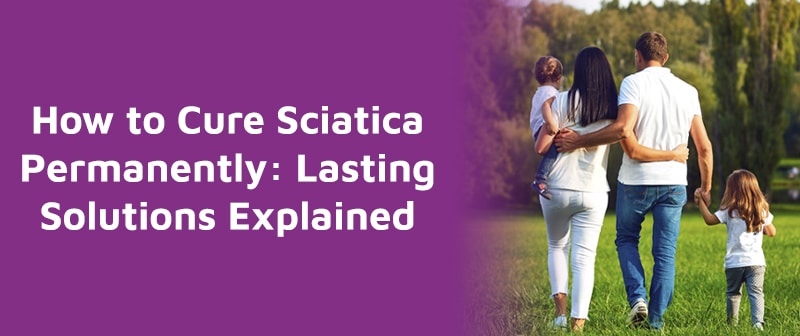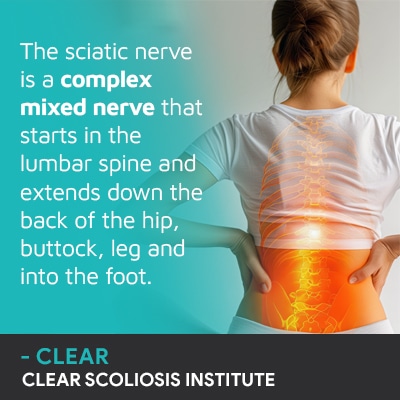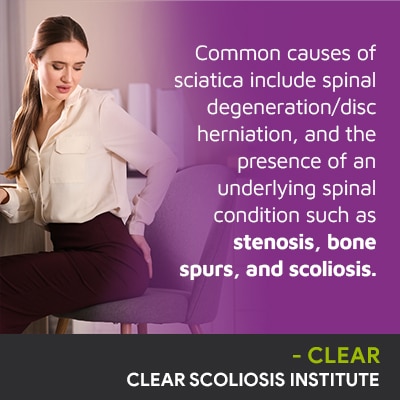
The only way to cure any condition permanently is to address its cause with treatment; otherwise, only symptoms are being addressed, but not the cause of the symptoms. Lasting solutions for sciatic nerve pain will depend on its underlying cause, but commonly include rest, lifestyle changes, medication, physical therapy, chiropractic care, and in severe cases, surgery.
When it comes to permanently curing sciatica pain, comprehensive assessment needs to determine the underlying cause of the nerve pain. Common causes of sciatica include spinal degeneration, disc herniation, spinal stenosis, and bone spurs.
The sciatic nerve is the largest in the body, so let's explore its characteristics and function.
The sciatic nerve is a complex mixed nerve that starts in the lumbar spine and extends down the back of the hip, buttock, leg and into the foot.
The nerve branches off in the back of the lower leg and knee to reach the rest of the leg and foot.
The sciatic nerve is the largest in the human body with an extensive pathway, and as a mixed nerve, it carries both sensory and motor signals, so facilitates sensation and mobility.

The sciatic nerve controls the lower body's muscles: back of the thigh, lower leg, and the foot muscles. The sciatic nerve facilitates the ability to stand upright and walk.
The nerve also provides sensation to those same areas, and not all sensations are pleasant, particularly when the sciatic nerve is irritated.
While many think it is, sciatica is not a condition itself; it's a term that references symptoms of sciatic nerve pain and/or discomfort felt anywhere along the nerve's extensive pathway, and the term doesn't indicate the cause.
Sciatic nerve pain can develop when the sciatic nerve is irritated in some way; this can involve the nerve becoming impinged (having less room to function within), pinched, compressed, and/or inflamed.
When the sciatic nerve, which runs throughout the lower body, experiences uneven pressure, a number of symptoms can develop.
The most common symptoms of sciatica are pain and discomfort felt along the nerve's route throughout the lower body.
Depending on the cause and severity, most cases of sciatica pain are felt down the body's left side, but it can also affect the right side, and in rare cases, it can affect both.
Sensory symptoms can involve a burning sensation, burning pain, leg pain, hip pain, and lower back pain.
Sciatica pain can range from mild and intermittent to chronic excruciating pain that's debilitating and disrupts quality of life.
Sciatic often has flare ups, during which time, symptoms intensify and then ease. Sciatic nerve pain that's caused by an overuse injury can improve and/or disappear within a number of weeks, particularly with rest, but if symptoms persist or come and go, this suggests an underlying cause that won't improve on its own.
In addition to pain and sensation issues, as the sciatic nerve is a motor nerve, its effects also involve the muscles and mobility of the lower body.
Symptoms of sciatica that involve the muscles can include muscle weakness, tight muscles in the affected leg, muscle spasms, and unhealthy muscles will affect mobility.
Sciatica can make it difficult to sit or stand for long periods of time and can change a person's gait.
The best way to reduce pain caused by sciatic nerve compression is to comprehensively assess symptoms so their underlying cause can be determined and addressed.
It's important that sciatica patients understand the nature of their complaint, that it's not a clinical condition, and that it has an underlying cause that treatment needs to address for any type of sustainable pain relief.
To reduce sciatica pain for the long term, its cause has to be determined, and this can involve a physical examination, discussing symptoms and checking mobility, particularly in the lower body, and imaging tests can also provide answers.
Sciatica symptoms are quite specific, and where they occur in the body is also specific, so while it's not always as simple to determine their underlying cause, oftentimes, discussing symptoms is enough to know the source of the pain and that the sciatic nerve is involved.
Common causes of sciatica include spinal degeneration/disc herniation, and the presence of an underlying spinal condition such as stenosis, bone spurs, and scoliosis.
The main cause of sciatica pain is natural age-related spinal degeneration, and this is also where certain lifestyle factors come into play.
For example, obesity and low activity levels can increase an adult's level and rate of degenerative changes, as can chronic poor posture.
Spinal degeneration occurs over time and most often starts with the discs that sit between adjacent vertebrae.
Once a disc starts to degenerate, it can become dehydrated and change shape as a result, and a change in shape can mean introducing uneven pressure to the affected disc's surroundings.
If a disc degenerates further and becomes a herniated disc, this means the disc's inner nucleus has pushed through the disc's outer annulus and is encroaching on space within the spine and its surroundings, including the spinal nerves.
If a disc degenerates and/or herniates in the lumbar spine and compresses the sciatic nerve, sciatica pain is a common result.

If lifestyle factors are involved, lifestyle guidance, modification, and physical therapy can help.
Physical therapy can help improve posture, weight, activity levels, and it can also help take pressure off the spine by improving the strength of the spine's surrounding muscles for more support.
Physical therapy and exercise can also help improve disc health by improving circulation and blood flow to an affected disc: a crucial aspect of improving disc health as the discs don't have their own vascular supply.
To treat a herniated disc caused by spinal degeneration, in addition to lifestyle changes and physical therapy, medication, hot-cold therapy, bracing, and back support can help.
Spinal stenosis is a spinal condition that causes a loss of space within the spinal canal, and the spinal canal contains the spinal cord: a bundle of 31 pairs of spinal nerves.
Stenosis causes a narrowing of the spinal canal which can lead to nerve compression, impingement, and irritation.
If spinal stenosis develops in the lumbar spine where the sciatic nerve runs, it can cause sciatica pain.
If spinal stenosis is diagnosed as the cause of the sciatic nerve pain, the stenosis has to be proactively addressed with treatment, and if successful, the sciatica pain will stop permanently because its cause is addressed.
Spinal stenosis can be addressed with medication, physical therapy, hot-cold therapy, bracing, chiropractic care, and in severe cases, surgery.
Bone spurs occur when extra ridges of bone are formed on the edges of bones, commonly where bones meet in the joints.
When bone spurs develop in the spine, particularly the lumbar spine, this can mean bony projections extending into the space needed for the sciatic nerve to function optimally within, and this can irritate the sciatic nerve.
Common treatment for bone spurs in the lumbar spine include lifestyle changes, medication, physical therapy, and in severe cases, surgery.
Addressing the bone spurs means taking pressure off the affected area, and this can reduce pressure on the sciatic nerve and can help treat sciatica.
The spine's natural curves and alignment are important for the spine, its parts, its surroundings, and the nerves within.
If an underlying spinal condition like scoliosis develops in the lower back, it can cause the lumbar spine to bend unnaturally to the side and twist, and in adults, this is a compressive condition that exposes the spine, and its surrounding muscles and nerves, to uneven pressure.
Sciatic nerve pain is a common complication of lumbar scoliosis.
As a structural spinal condition, to minimize and cure the symptoms of lumbar scoliosis, like sciatica pain, the scoliosis has to be impacted primarily on a structural level, and this can be worked towards through chiropractic care.
Conservative non-surgical scoliosis treatment is multifaceted so also applies physical therapy, corrective bracing, lifestyle guidance, and rehabilitation: all treatment options with potential to cure severe pain caused by compression of the sciatic nerve.
As the unnatural spinal curve is reduced, pressure is taken off the spine's surroundings and can ease sciatica pain.
Sciatic nerve pain has a number of causes, and in order to cure sciatica permanently, the sciatic pain has to be stopped at its source: the underlying cause.
So when it comes to addressing the question of how long does sciatica pain last, the answer will be case-specific and is largely shaped by severity and cause.
Common causes of sciatica pain include spinal degeneration causing disc herniation, lumbar spinal stenosis, bone spurs in the lumbar spine, and lumbar scoliosis.
The only way to relieve sciatica pain permanently is to determine its underlying cause and customize a proactive treatment plan accordingly.
Sciatica exercises can help relieve other sciatica symptoms, and sciatica treatments can include medication, rest, lifestyle modification, physical therapy, chiropractic care, hot/cold therapy, and in severe cases, surgery.
Here at the CLEAR Scoliosis Institute, we specialize in innovative non-surgical treatment options for a variety of spinal conditions and complaints including scoliosis and sciatic nerve pain.

CLEAR provides a unique and innovative way of understanding scoliosis. Sign up to receive facts and information you won’t find anywhere else.
